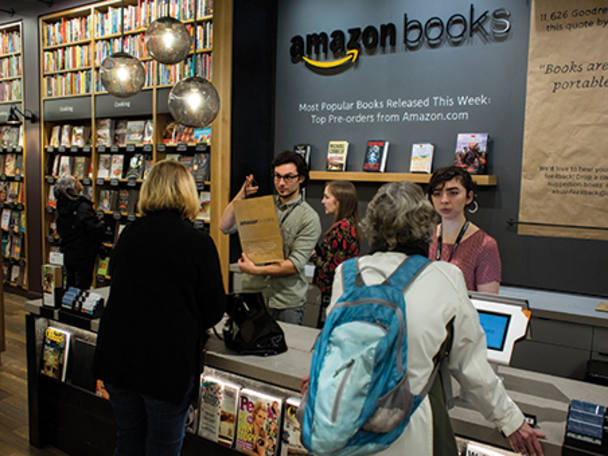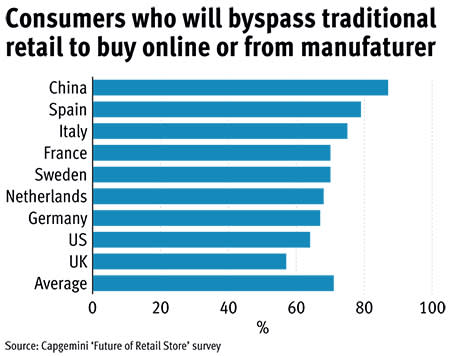Regular readers will remember the special in-depth feature we published on e-tail giant Amazon (US:AMZ) last year and its steady advance on the retail sector. Many industry insiders have credited the 'e-tailer' with forcing change in the industry, not just in the general evolution of online shopping, but also with logistics and technology. And yet, despite Amazon's modern business model, the group is still expanding its physical retail space, opening a bricks-and-mortar bookshop in Seattle in November 2015. At last count, there were plans for five more stores across the United States - to join the three already operating in Seattle, Portland and San Diego - as well as several pick-up locations across California. Unlike the bookshops, these new locations will allow customers to drive in, park, pick up their items and leave in under 15 minutes - effectively a click-and-collect depot under Amazon's auspice.
Despite ongoing rumours that the group wants to open between 300 and 400 new locations, it's fair to say Amazon is moving slowly with its expansion into physical retail. Amazon is also focused on a niche area with this strategy too - namely traditional bookstores as opposed to the hundreds of thousands of product categories currently accessible via the website. It's perhaps ironic, given its primacy among online booksellers, but Amazon has been forced to augment its business model to serve modern consumers that still want to browse books in person prior to purchase. In the Seattle store, books are priced "fluidly", meaning they match the prices offered online, while customers can also browse a range of related technology products such as Kindle e-readers, the Fire TV and Echo or 'Alexa' Amazon's voice-controlled home assistant.
No easy assumptions - physical retail still has value
Amazon's move into the world of physical retail suggests this format still has value, but stores have to evolve to better serve modern shoppers' appetites. Amazon is clearly taking direction from its digital business, focusing on what customers value about the online experience before bringing it to the high street. The statistics make for interesting reading. According to Massachusetts-based software firm DemandWare, the number of visits to stores worldwide has increased by 16 per cent since 2014, while another Massachusetts software group, TimeTrade, said 65 per cent of US consumers would prefer to shop in a store if they knew an item was in stock at a nearby retail location, even if it was readily available online. TimeTrade also said US consumers generally prefer shopping in store, with 85 per cent wanting to touch and feel products before buying them. More than a third also said they didn't like waiting for items to ship, while 30 per cent said they still value advice from sales associates.
Big data, big results
According to in-store analytics company RetailNext, the evolution of e-commerce was largely driven by retailers' ability to collect more data on their customers than ever before. Using online analytics tools to track their customers' behaviour, online retailers were able to shape marketing campaigns, tailor discounts and special offers and even design product categories in the hope of driving better sales growth. The inability of physical retail locations to provide the same sort of coherent insight into customer behaviour put them at a distinct disadvantage to their online competition.
But new technological developments means this is no longer the case. Analytics companies can now harness in-store Wifi systems, video cameras, payment cards, point-of-sale systems and external factors like weather patterns to gather information on shoppers' habits. This has also proved useful for owners of retail parks, shopping centres and even manufacturing warehouse sites. And this kind of information gathering can shape consumers' behaviour in the future too. For example, their behaviour in store means retailers can better tailor what is offered to them online, via web dashboards, mobile apps and even give them the ability to send real-time alerts via email or text message - all this even before the customers have even left the store.
The 'phygital' opportunity - multi-channel retailing
It's not a trend that anyone saw coming. With the arrival of online pure-plays such as Asos (ASC) and the subsequent scale of disruption to the market, you could have been forgiven for thinking that retail was headed in only one direction. But as digital commerce gathered pace, the need to complement online retail with more traditional forms has become increasingly apparent. This has prompted other companies to follow Amazon and open 'pop-up' or 'concept' stores to trial the popularity of physical locations.
One such example is privately-held fitness wear retailer Active in Style. Having started life as an online-only retailer, the company recently opened doors in London's upmarket Chelsea area to take advantage of the growing social trends in health and wellness. Founder Caroline Lucie told us it's "much harder" to track customer behaviour in store, but says she has witnessed an "incredible response" to the brand since opening the physical stores. The company previously experimented with other temporary sites, but Ms Lucie says she "would not give up" the brand's Chelsea store now. "It's expensive," she admits, "but we've been able to harness the engagement with the brand online to drive customers to the store".
Active in Style is not alone. Although no stranger to store shopping, luxury retailer Burberry (BRBY) opened what was intended to be a temporary, pop-up shop in Covent Garden. It was designed to play host to the group's new beauty and make-up products. Becoming known as the Burberry Beauty Box, it proved so popular it's still there.
Interestingly, bosses at fast fashion e-tailer Asos aren't making the same strategy a priority. Chairman Brian McBride has publicly criticised the idea of multi-channel retailing - a modern day buzzword for the future of the retail sector. Mr McBride suggests the term was invented by retail groups trying to convince themselves, investors and the public that something could still be done with physical stores. In his view, the high street is "demanding" and "cruel" and "struggles to keep up with change". Instead, Asos will focus its resources on mobile sales, believing e-commerce still has the potential to double its share of the retail market. Last year, 51 per cent of total orders placed on Asos came from mobile platforms following 7.5m new downloads of the group's mobile app during the financial year.
But analytics expert ShopperTrak argues blending technology with the human touch offered by retail stores is "the only way" to deliver an omnichannel, 'best of both worlds' experience that shoppers will come to expect in the future. This won't be without challenges, however, as retail stores will have to raise their game to become every bit as streamlined, well-stocked, and easy to navigate as what's available on the web. What's more, their online offering will be expected to work seamlessly with the physical store estate, which means total integration of the distribution network for both online and offline systems. It's not hard to find examples of where this has been difficult. Both Tesco (TSCO) and John Lewis have been forced to increase the threshold on minimum spends for their click-and-collect services as prior limits were deemed too costly and inefficient.
IC VIEW:
Arguably, the biggest challenge of all is the global nature of retail. For UK-centric companies, the chance of success in physical retail is actually better: its estimated only 57 per cent of British consumers would bypass traditional retailers to buy online or direct from manufacturers. In China, however, this number is as high as 87 per cent (source: Capgemini research). It's also expensive to refurbish stores to better serve modern consumers, and there's little evidence of how new forays into physical retail have fared outside of London. Given the number of store closures and empty buildings on rural high streets, one would assume the answer isn't encouraging. Of course, there's also the counter argument - one Amazon's already picked up on - that consumers want shops to serve simply as click-and-collect locations. The bad news is a truly modern retailer will probably be expected to have it all.
Favourites
We don't blame Asos for wanting to stick to what it does best. We've long been bullish on the group's future - particularly as it expands its digital and global footprint. The evolution of physical retail space doesn't detract from the company's prospects in our view. If anything, they'll have to watch their back on their own turf. After a rocky start, shares in competitor Boohoo.com (BOO) are flying. The latter also ran a pop-up store in New York City in 2014. While it's difficult to form a value-based argument for either stock, both shares clearly have momentum. From the traditional retailers, we see Marks and Spencer (MKS) as having a real opportunity here. Digital sales are finally gaining traction while Steve Rowe's more disciplined approach to store estate should help streamline operations.
Outsiders
The stocks on our bearish list aren't there because of their lack of digital prowess first and foremost, but we see the likes of N Brown (BWNG) and Bonmarché (BON) as faced with an enormous task to make their offering relevant to the modern day consumer. This has more to do with product range than availability - after all, many of N Brown's merchandise brands are available online - but we fundamentally see 'over-50s' retailers or 'plus size' ranges as increasingly outdated concepts.









